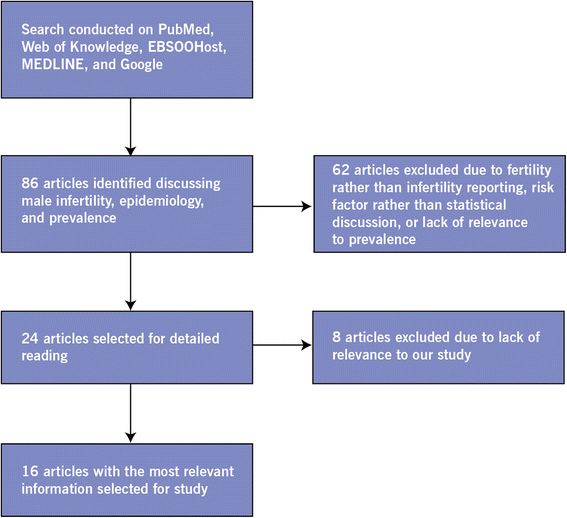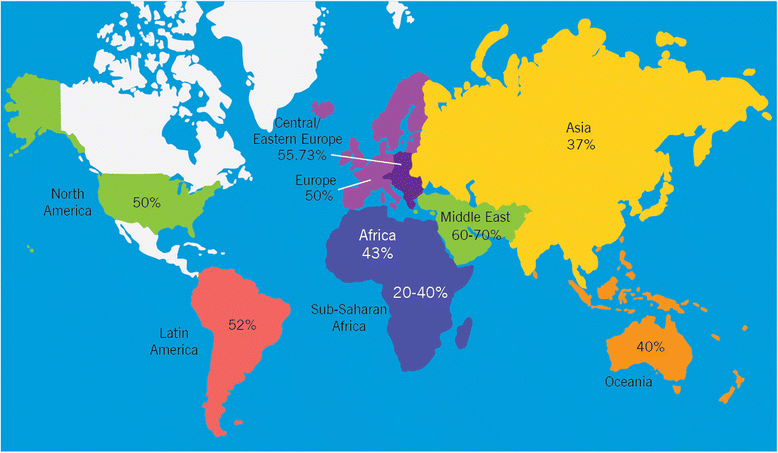A unique view on male infertility around the globe
- PMID: 25928197
- PMCID: PMC4424520
- DOI: 10.1186/s12958-015-0032-1
A unique view on male infertility around the globe
Abstract
Background: Infertility affects an estimated 15% of couples globally, amounting to 48.5 million couples. Males are found to be solely responsible for 20-30% of infertility cases and contribute to 50% of cases overall. However, this number does not accurately represent all regions of the world. Indeed, on a global level, there is a lack of accurate statistics on rates of male infertility. Our report examines major regions of the world and reports rates of male infertility based on data on female infertility.
Methods: Our search consisted of systematic reviews, meta-analyses, and population-based studies by searching the terms "epidemiology, male infertility, and prevalence." We identified 16 articles for detailed study. We typically used the assumption that 50% of all cases of infertility are due to female factors alone, 20-30% are due to male factors alone, and the remaining 20-30% are due to a combination of male and female factors. Therefore, in regions of the world where male factor or rates of male infertility were not reported, we used this assumption to calculate general rates of male factor infertility.
Results: Our calculated data showed that the distribution of infertility due to male factor ranged from 20% to 70% and that the percentage of infertile men ranged from 2·5% to 12%. Infertility rates were highest in Africa and Central/Eastern Europe. Additionally, according to a variety of sources, rates of male infertility in North America, Australia, and Central and Eastern Europe varied from 4 5-6%, 9%, and 8-12%, respectively.
Conclusion: This study demonstrates a novel and unique way to calculate the distribution of male infertility around the world. According to our results, at least 30 million men worldwide are infertile with the highest rates in Africa and Eastern Europe. Results indicate further research is needed regarding etiology and treatment, reduce stigma & cultural barriers, and establish a more precise calculation.
Figures


Similar articles
-
Antimicrobial susceptibility among gram-negative isolates collected from intensive care units in North America, Europe, the Asia-Pacific Rim, Latin America, the Middle East, and Africa between 2004 and 2009 as part of the Tigecycline Evaluation and Surveillance Trial.Clin Ther. 2012 Jan;34(1):124-37. doi: 10.1016/j.clinthera.2011.11.023. Epub 2011 Dec 9. Clin Ther. 2012. PMID: 22154196
-
Geographical variations in the prevalence and management of cardiovascular risk factors in outpatients with CAD: Data from the contemporary CLARIFY registry.Eur J Prev Cardiol. 2015 Aug;22(8):1056-65. doi: 10.1177/2047487314547652. Epub 2014 Aug 21. Eur J Prev Cardiol. 2015. PMID: 25147344
-
[The AIDS epidemic widens].Gesundheitswesen. 2003 Jun;65(6):422. Gesundheitswesen. 2003. PMID: 12903643 German. No abstract available.
-
Global estimates of prevalence of HCV infection among injecting drug users.Int J Drug Policy. 2007 Oct;18(5):352-8. doi: 10.1016/j.drugpo.2007.04.004. Epub 2007 Aug 7. Int J Drug Policy. 2007. PMID: 17854722 Review.
-
Estimating the number of men who have sex with men in low and middle income countries.Sex Transm Infect. 2006 Jun;82 Suppl 3(Suppl 3):iii3-9. doi: 10.1136/sti.2005.019489. Sex Transm Infect. 2006. PMID: 16735290 Free PMC article. Review.
Cited by
-
The Molecular Basis of Multiple Morphological Abnormalities of Sperm Flagella and Its Impact on Clinical Practice.Genes (Basel). 2024 Oct 13;15(10):1315. doi: 10.3390/genes15101315. Genes (Basel). 2024. PMID: 39457439 Free PMC article. Review.
-
Exposome Profiling of Environmental Pollutants in Seminal Plasma and Novel Associations with Semen Parameters.Environ Sci Technol. 2024 Aug 6;58(31):13594-13604. doi: 10.1021/acs.est.3c10314. Epub 2024 Jul 25. Environ Sci Technol. 2024. PMID: 39053901 Free PMC article.
-
The potential impacts of circadian rhythm disturbances on male fertility.Front Endocrinol (Lausanne). 2022 Oct 6;13:1001316. doi: 10.3389/fendo.2022.1001316. eCollection 2022. Front Endocrinol (Lausanne). 2022. PMID: 36277693 Free PMC article. Review.
-
Analysis of research trends (2014-2023) on oxidative stress and male fertility based on bibliometrics and knowledge graphs.Front Endocrinol (Lausanne). 2024 Jan 23;15:1326402. doi: 10.3389/fendo.2024.1326402. eCollection 2024. Front Endocrinol (Lausanne). 2024. PMID: 38323105 Free PMC article.
-
The Evolving Landscape of Male Varicocele Pathophysiology in the Era of Multi-Omics: A Narrative Review of the Current Literature.Biology (Basel). 2024 Jan 28;13(2):80. doi: 10.3390/biology13020080. Biology (Basel). 2024. PMID: 38392299 Free PMC article. Review.
References
-
- Matetakufa SN. Infertility: Our Own Gift. New Internationalist. 1998. http://newint.org/features/1998/07/05/infertility/ Accessed 17 December 2014.
-
- Martinez G, Daniels K, Chandra A. Fertility of men and women aged 15-44 years in the United States: National Survey of Family Growth, 2006-2010. Natl Health Stat Report. 2012;51:1–28. - PubMed
Publication types
MeSH terms
LinkOut - more resources
Full Text Sources
Other Literature Sources
Medical

